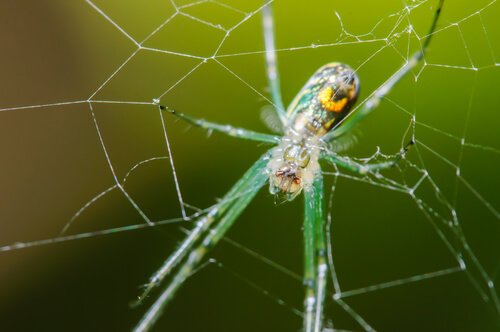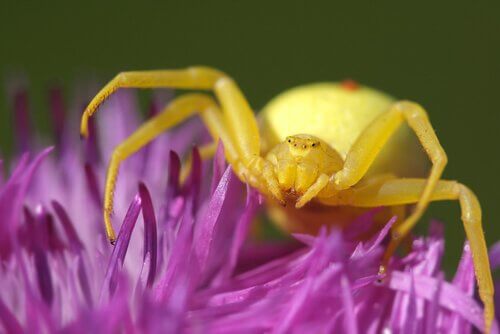Smiling Spiders: Behavior and Habitat

There are several members of the theridiidae family that always seem to be happy. Or, at least they look like they are! In this article, we’ll give you some information about why these fascinating creatures are known as “smiling spiders”.
The smiling spider group
You can find many dangerous and poisonous species in this large family that’s made up of over 2,000 species. The black widow is one example. However, there are also others that are known as ‘smiling spiders’ because they always have a ‘happy face’ on their bodies.
As you read, we’ll just point out that the spiders aren’t actually laughing of course. Their bodies have designs that resemble a smile. In addition to that, their eyes look quite similar to a clown’s, rather like the Joker in Batman.
The Theridion grallator is the most famous of these spiders. They’re better known as ‘Hawaiian Happy-Face Spiders’. As their name suggests, they inhabit the islands of Hawaii, mostly in the rainforests of O’ahu, Moloka’i and Maui, which are nearly 1,000 feet high.
This spider is about five millimeters long and each one has a different pattern on its body. While most have the ‘smiling face,’ no two are the same. Their designs even differ from one island to another.
Scientists believe this is how they camouflage themselves to protect themselves from birds, the spider’s only natural enemy at this latitude. Also, this arachnid uses another technique to protect itself. It will hide under plant leaves during the day and use that time to make their tiny webs. They use these webs to trap their food.
Additionally, their webs help them orient themselves and find a mate during the breeding season. It’s worth noting that copulation takes place during the night and the males die after mating.
Smiling spiders and their interesting names
While the Hawaiian spider is the most famous of all the smiling spiders, scientists have found new species on the Caribbean islands and in South America. These spiders have very interesting names, as well as bodies ‘painted’ in very curious ways.
Scientists and researchers from the University of Vermont (United States) have decided to give arachnids the names of renowned people from around the world. They wanted to do this as a way of honoring people who defend human and animal rights.
Because of this, Spintharus spiders now have names such as Leonardo Di Caprio, Barack Obama, David Attenborough (a British scientist), Berni Sanders (A Senator from Vermont) and Michelle Obama.
Smiling spiders are native to Cuba, the Dominican Republic, Jamaica, Puerto Rico, Mexico, Colombia, the Lower Antilles, and the states of Florida and South Carolina in the United States.
More smiling spiders
In addition to the ones recently discovered in the Caribbean and South America, there are other smiling spiders that have really caught our attention.
1. Cat face spider
Its scientific name is Araneus gemmoides and it’s a weaver spider that lives in the western United States. While it may look creepy, it’s not actually poisonous. The females are larger than the males, but they still don’t even reach a centimeter in length.

2. Orchard spider
The Leucauge venusta is a spider from the east coast of the United States. It lives in orchards, as well as in cities and fields. It has reddish or orange spots on a black background that look like two eyes and a smiling mouth. It’s not poisonous, but it looks rather like a black widow.

3. Golden crab spider
This spider appears to be more scared than smiling. It’s a small and stealthy species that knows how to camouflage itself extremely well. It will take on the look of a flower and wait for its prey – such as a bee – completely motionless.

Smiling spiders are just another amazing example of how wonderful and interesting nature is!
All cited sources were thoroughly reviewed by our team to ensure their quality, reliability, currency, and validity. The bibliography of this article was considered reliable and of academic or scientific accuracy.
Gillespie, R. G. (1990). Costs and Benefits of Brood Care in the Hawaiian Happy Face Spider Theridion grallator (Araneae, Theridiidae). American Midland Naturalist. https://doi.org/10.2307/2426552
This text is provided for informational purposes only and does not replace consultation with a professional. If in doubt, consult your specialist.